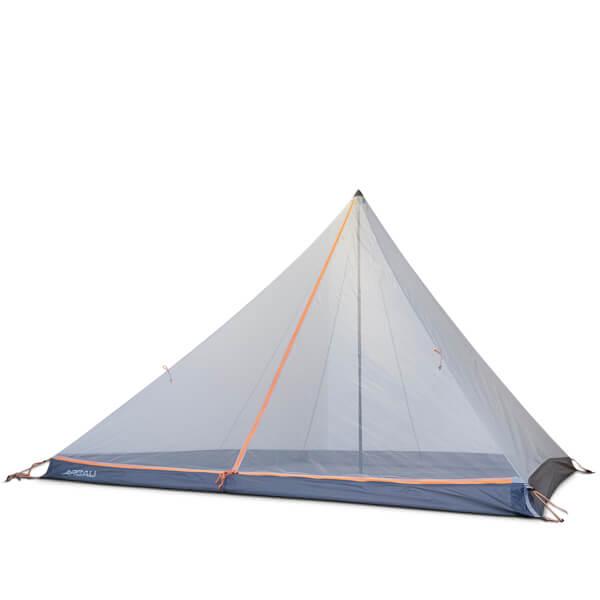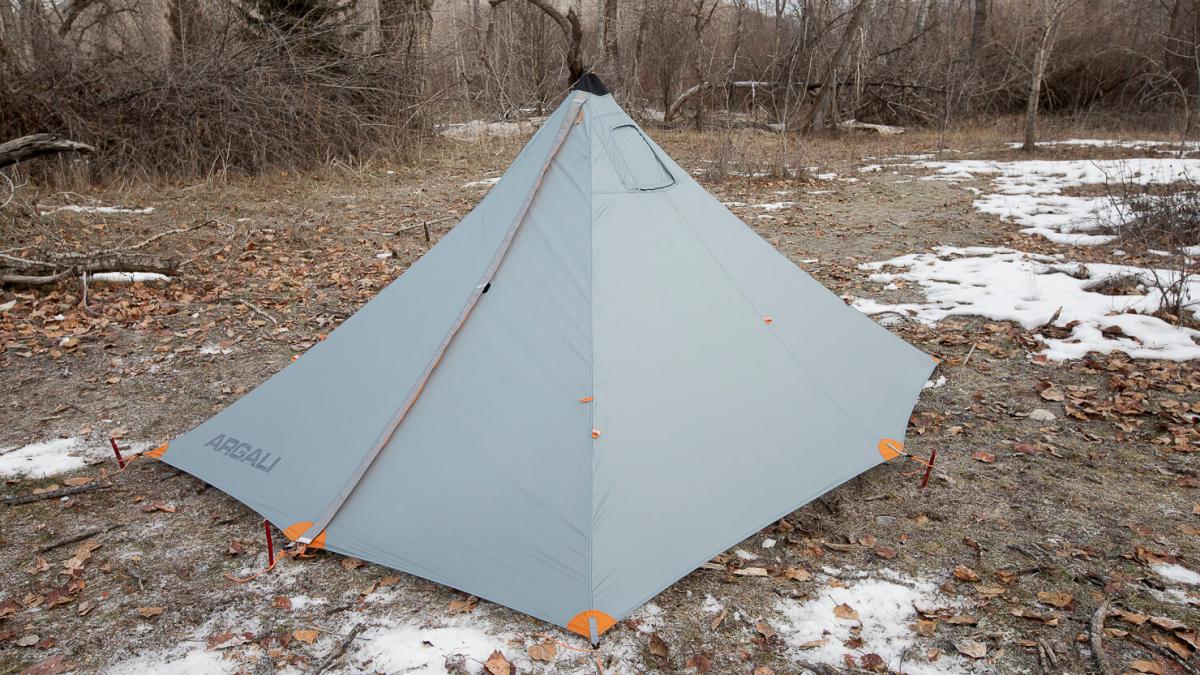
Top 6 Features to Look for in a Backcountry Shelter
By Josh Kirchner
Swimming through the sea that is backcountry shelters these days can be exhausting. There are more options out there for tents than one can shake a stick at and even more opinions on all of them. This can make finding the right backcountry tent for future adventures quite overwhelming. The bottom line is we need a tent that meets our needs as backcountry hunters, not for some rando on the internet. On that note, and brand aside, it is the features of a tent that we should be paying attention to. These are the things that will make life easier, or harder for that matter, on backpack hunts. Find the right features for you, and you’ll be that much closer to finding the right shelter for you as well. Here are some things to key in on when searching for a backcountry shelter.
Weight and Packability
If there is one area where backpack hunters spend a lot of time thinking about gear, its weight and packability, or how small a tent packs down. Both are incredibly important and for good reason. The less weight one carries around day after day, the less wear and tear they’ll put on their body. And the more room in their backpack, the more room they’ll have for other gear, or even food for that matter. This means that someone could bring more food along, which would add days to their trip, or more clothes along, which could propel them further into the late season due to the bulkier clothing required. Shelters are no exception to this, being part of gear items making up “The Big 3″(sleeping bag, pad, and shelter). These are pieces of gear that are mainstays, but also tend to be some of the biggest and heaviest we carry on backpack hunts. No matter if you’re going for 3 days or 10 days, these items are a constant in our backpacks. So, slicing down the weight and size of a shelter matters a lot.
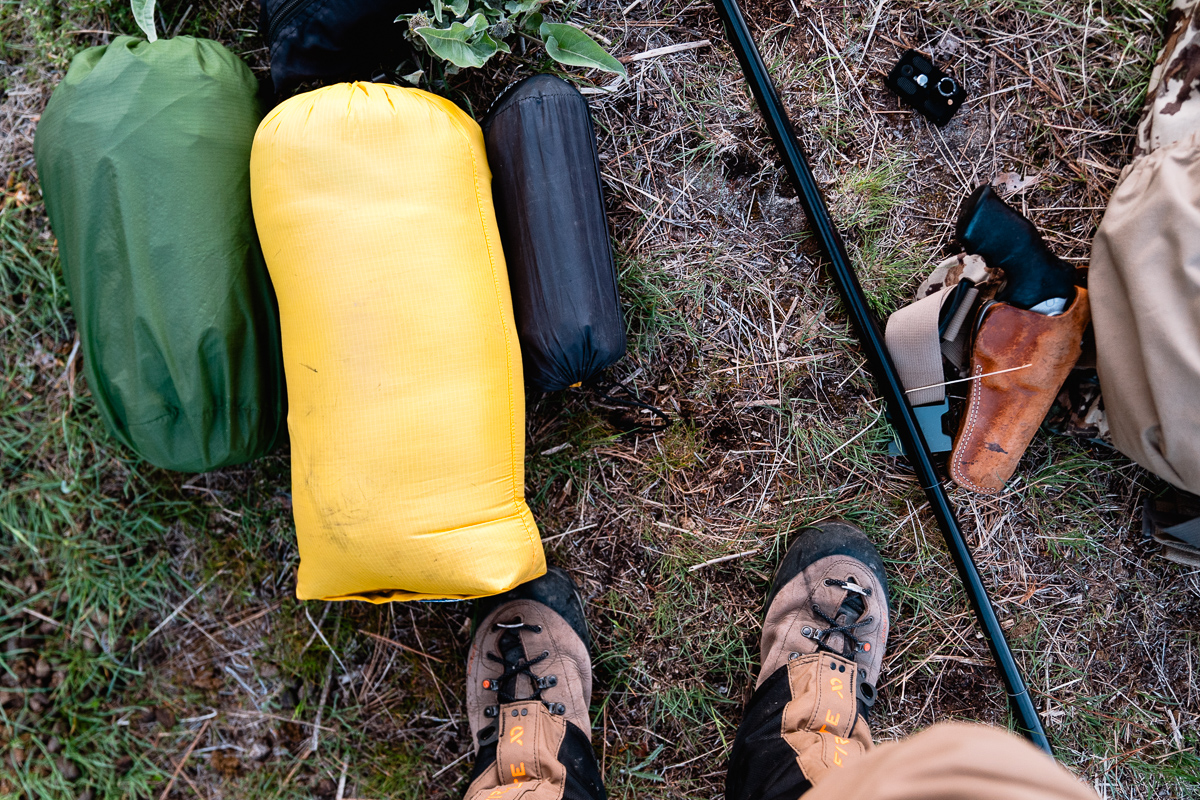
Shelters can range anywhere from 7+ pounds all the way down to mere ounces and pack down as big as a foam roller or as small as a Nalgene bottle. Where one ends up there is going to be dependent on their personal needs and budget of course. In general, the higher the price tag, the more lightweight and packable a shelter will be.
Floor Space, Usable Space, and Shape
Floor space, usable space and shape all add up to how much room a tent has to sleep and hang out. Some shelters are like coffins and offer just enough room for 1 person to sleep and that’s it. Others are like a palace that will sleep 4+ and allow extra gear to be laid out, room to cook, sit up, and even have a stove in them to fight off the bite of winter during the late season. On top of that, there is no standard size guide from different manufacturers on how much room is needed for a 1, 2, or 4 person tent. It's the wild west out there, and it's important to really get a feel for the tent before buying. One needs to ask themselves a few questions here to better understand which end of the spectrum they’ll be on.
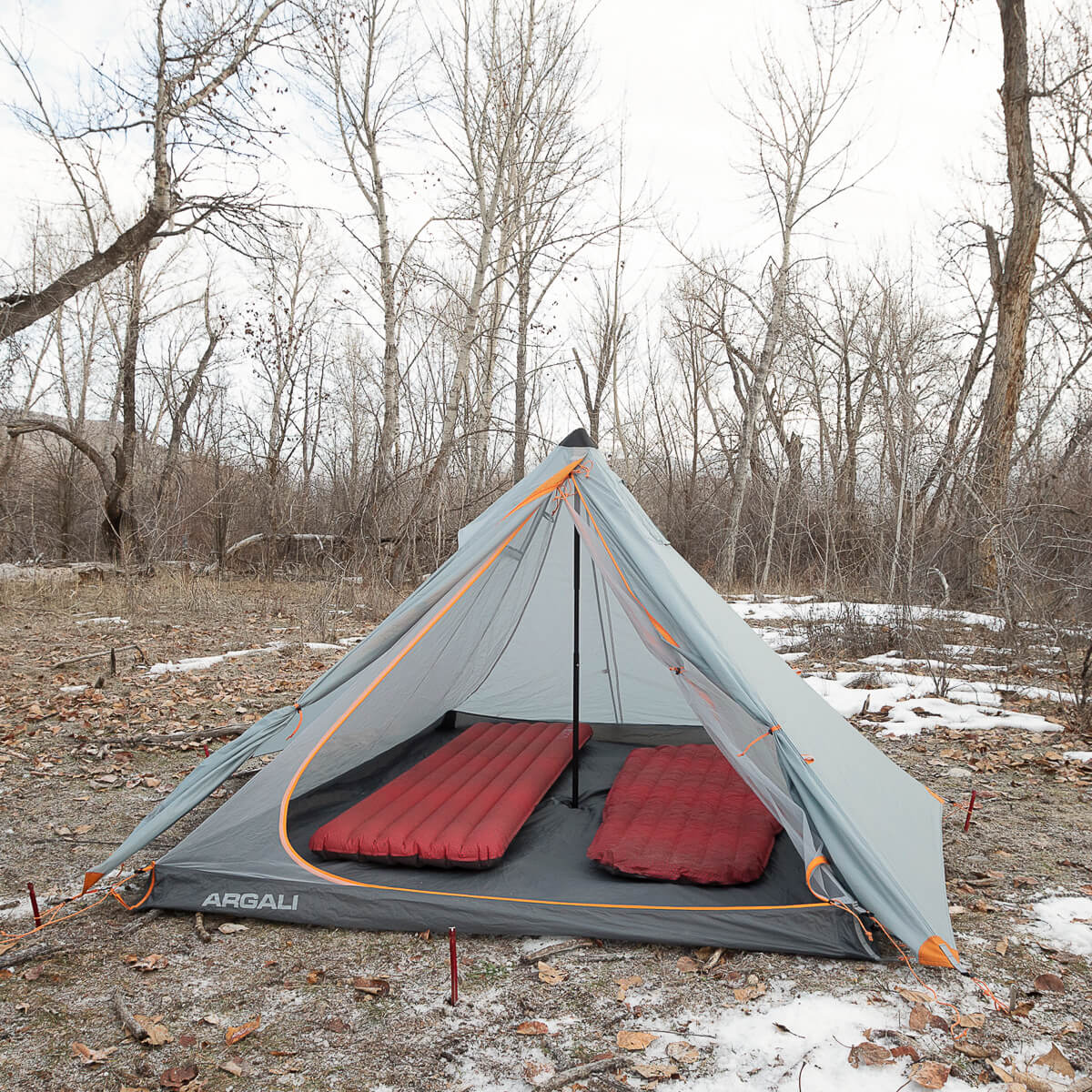
First, what are you looking for out of a shelter and how much extra space do you want? Shelters can be looked at as merely a place to sleep or they can also be looked at as a place to hold up for a bit, weather out a storm, store extra gear, etc. In the early season, you may care less about being able to be comfortable, but when it is cold out, having enough usable space inside the tent to hang out comfortably can be a mental make-or-brake situation. If you've ever had to lay down in a coffin-shaped tent for extended periods of time, you'll know what I mean.
All of these things will dictate what size shelter one will go with. For the ultralight minimalist, there’s no question. Go with a 1 person design. Just know that you’ll likely not have much more room than your sleeping pad inside. This could be potentially annoying if the shelter you’re using develops condensation. I’ve woken up before with my sleeping bag completely wet on the outside because the shelter’s walls were touching it.
For a bit more room a 2 person is generally perfect for 1 person. It offers just enough room to sleep and lay out some extra gear on the sides of your pad (phone, boots, clothing, etc.). To add to that, a 3 person is just enough room for 2 people. The bigger you go with a shelter, the more weight, less packability, and bigger footprint. Bigger footprints will be more difficult to find spots to pitch. So, if you’re in very steep country, with very little flat spots, you’d be better off with a smaller shelter that doesn’t take up as much room.
And then there is the shape of a shelter. The shape of a shelter will have an impact on the footprint, headspace, how versatile and easy it is to pitch, and how it handles weather. A shelter with a very round floor, while providing more room, will take up much more space than one with a more rectangular floor with less room. If standing up, or even sitting up, inside a shelter is important to you, then something like a bivy sack should be the last thing you look at. Not only are bivy sacks constraining, but when the weather hits they are less than ideal. And when that weather hits, steeper walled shelters are going to shed rain and snow better. Some models can develop a sump at the top, which could be problematic.
Fabric
I’ll go out on a limb here and say that most backcountry hunters are hard on their gear. For that reason, tent fabric is another feature that needs to be considered when picking a shelter. What a tent is made out of will impact things like durability, how it handles UV rays (sun exposure can significantly degrade tent fabric durability), and the potential for any sagging when wet.
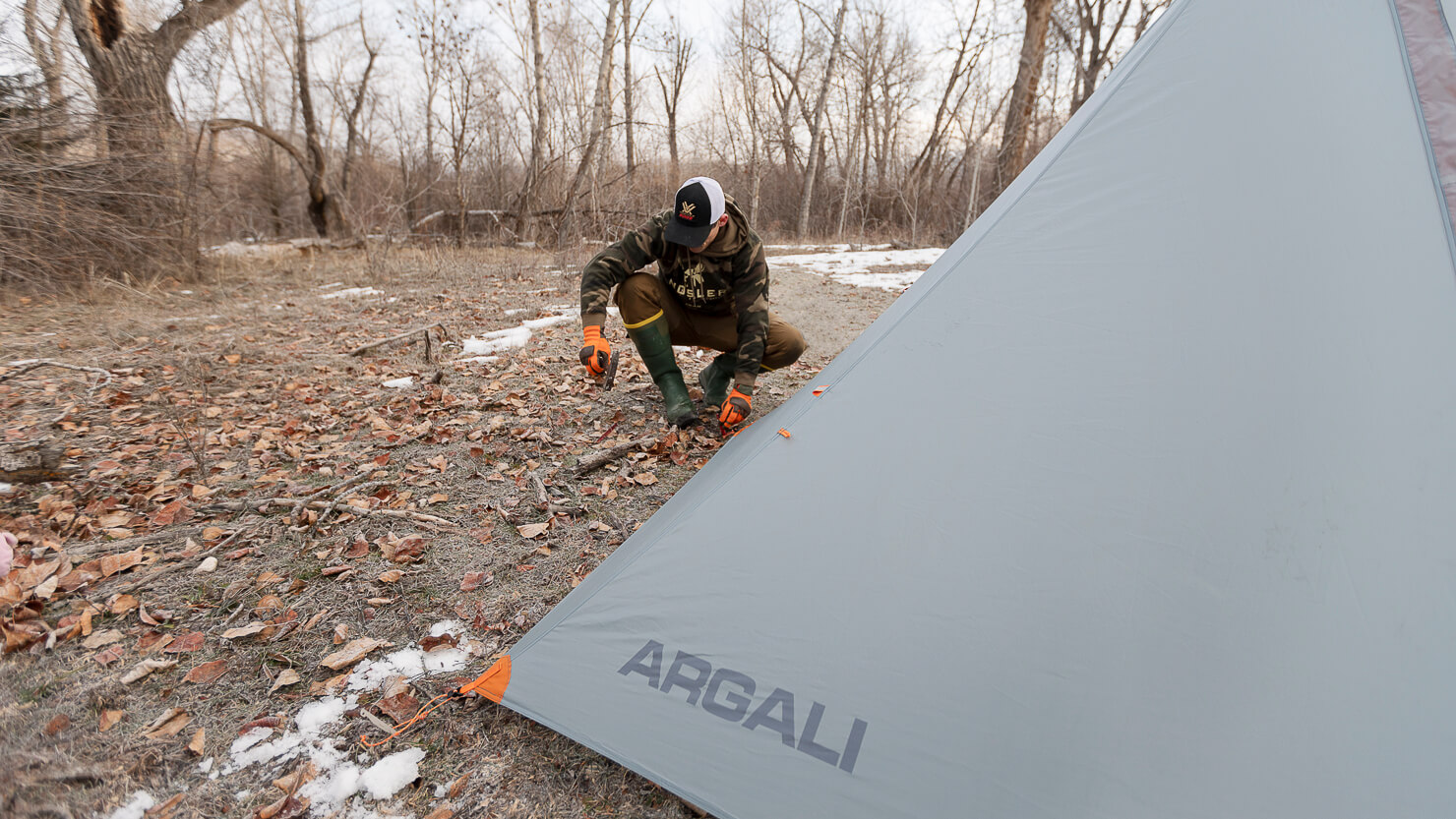
When it comes to tent fabrics, you’ve basically got 3 options. Nylon, polyester, and dyneema (formerly cuben fiber). Nylon is without a doubt the most popular and widely used out of the 3. It has a great weight to strength ratio and doesn’t break the bank. It also has great abrasion resistance. With that being said, nylon will sag when wet because it absorbs water (probably the most annoying part about nylon tents, particularly with single pole pitched and floorless shelters) and will deteriorate from UV exposure even with moderate sun exposure. This will hack away at longevity and durability.
Polyester doesn't sag when wet and has much higher UV resistance than nylon. Polyester is naturally hydrophobic, meaning it can't absorb water, and therefore doesn't stretch under condensation or wet weather like nylon. Polyester fabrics have also caught up to nylon in terms of tear strength and abrasion resistance and there is virtually no difference in terms of durability. Because of all of this, it is our opinion that updated polyester technology offers the best of all worlds for rain fly and/or tent fabrics.
If you can afford it, and if you really want the lightest fabric available, Dyneema tents are a great option. It doesn't absorb water, stretch, and has phenomenal UV resistance. The downside is Dyneema doesn't compress down very well and with mid-sized tents it can be a bit annoying to pack them around due to the size. Dyneema has incredible tear strength, but isn't as impervious to abrasion resistance as nylon or polyester. Still, there is no other waterproof fabric as light as Dyneema, and if you are willing to pay more money, it is a great option.
Freestanding vs. Non-Freestanding
Another feature to keep on your radar is freestanding vs. non-freestanding tent designs. From the outside, they might look fairly similar, but it's the inside we are referring to. And particularly how the tent is supported. This is another one of those things that flies under the radar of many until they've actually experienced each for themselves. Let us break it down for you.
Freestanding tents are, well, freestanding. This means that the tent can stand up on its own without the aid of stakes. Picture your more traditional dome style backpacking tent. They're generally pretty easy to set up, and once you do get them set up, you can even pick the tent up and turn it into a different position if you'd like. This is a great bonus and will aid in getting the tent placed in just the right spot. With that though, freestanding tents are going to be a little heavier, due to having to carry in their more complex pole system. That pole system, while nifty, is also more prone to breaking, which can be a pain to repair in the field.
Non-Freestanding tents are tents that cannot stand up on their own without the aid of stakes. Tipi style shelters are non-freestanding. In general these shelters can usually be set up with a trekking pole, meaning that we won't have to carry in an extra set of poles, because we already have trekking poles with us anyway. The result is a more lightweight setup. These shelters also have a higher room to weight ratio. They're much more spacious than competing freestanding models for less weight. On the flip side though, these are mostly going to be single wall designs with less airflow. Condensation can become an issue because of this. Which presents the potential for sagging fabric, should you be using a nylon shelter.
Floorless or Nah?
Floorless tents have gotten a lot of attention in recent years, so naturally we’re posed with another question. Do we go floorless or stick to the good ol trusty bathtub floor offered in most shelters? The answer to this is going to be dependent on time of year/environment, and honestly what you’re comfortable with.

Aside from those variables, floorless models offer a simplistic experience, as well as the lightest option. It’s just you and the ground. There is no tracking in mud when running a floorless shelter. These are also usually pretty lightweight setups, due to the absence of material where a floor would be. And then there is the potential to run a wood stove when the temps drop in many models. A game changing feature for late season hunting. Also, floorless shelters are far less of a hassle to set up during times of precipitation. Meaning, the inside of the shelter isn’t going to get all wet like the floor of a traditional freestanding tent might.
If you've never run a floorless shelter, there is a mental barrier to overcome about whether or not they would keep water from running under your tent and truly protect you from the weather. The answer to that is yes, they absolutely do provide 4 season protection, but you just have to pick the right spot to pitch your tent. They are a great way to shed weight for backpack hunting, and there is a reason they are catching on within the hunting world.
There some situations when a floorless shelter doesn't make sense though. For instance, on a personal note, living in Arizona, I’d never run a floorless model during our summer months, due to rattlesnakes, scorpions, and chiggers. When the temps drop though here, I’d do it in a heartbeat.
Probably the biggest downside I can think of with running a floorless shelter is possibly dealing with the occasional visitor or visitors for that matter. There is the potential for the occasional mouse or other critter to pay you a visit, and during the spring or early summer, for bugs to get inside your tent. In those situations, a fully enclosed tent is a good idea.
With the potential for creepy crawlies, there are a few downsides of a floorless shelter. For one, there is definitely a learning curve to setting these up. Whether it’s a tipi style or tarp, getting the right pitch takes some practice. These shelters are also traditionally single wall designs, which means there is a higher chance for condensation. In bigger shelters it’s not that big of a deal, but smaller ones can prove, like we said earlier, annoying.
Front Entry vs. Side Entry
Last, but certainly not least, we land on front entry vs. side entry in shelters. This is something that somewhat flies under the radar until you’ve been exposed to both styles. With tipi style shelters or tarps, this isn’t a factor. For freestanding tents though, you need to consider where the door is. You’ll either not mind either style, or really dislike one over the other.

Front entry shelters aren’t nearly as prevalent as side entry, but they have their advantages. The first being the slightly increased height of the door. Especially for taller individuals, this is a great feature. It allows them to get in and out of the tent easier, instead of having to really scrunch over to avoid hitting their backs on the top of the entry. While the door might be higher though, front entry tents can be harder to get situated in. Depending on whether you sleep with your head or feet at the door, you’ll either have to flip around once inside or crab crawl into the tent. For multiple people, front entry can be a nice feature though, because there is no climbing over one another to reach the door. These shelters also tend to have a smaller footprint than that of side entry shelters. Minimalists often lean more on front entry than side entry.
Side entry shelters are definitely the most popular between the two. The biggest advantage is most people find it much easier accessing the entirety of the shelter. They can easily get in and out, while at the same time being able to reach inside and grab anything that they need without climbing over things like one would have to in a front entry. Another advantage of a side entry, is the vestibule size. Front entry vestibules are usually more narrow and don’t offer as much room to store gear. This not only limits the real estate for the vestibule, but makes one have to either crawl over all of their stuff to get out or move it to get out. With side entry, that isn’t an issue. Not only can gear be stored, but there is room to get in and out of the tent. And lastly, particularly with a multi person tent, each person will have their own vestibule with side entry models, and even their own door. This just makes organizing and accessing the inside of the tent much easier for multiple people. However, if there is only one door one person will have to climb over the other in order to access the door. And at that point, the vestibule will likely be filled up to the brim with 2 people’s gear, rather than one, offering less space than if there were two vestibules.
The take home message is to really pay attention to the door. Understand how it is designed and understand how the designer or manufacturer thought through the door location and ease of getting in and out.
To Cap Things Off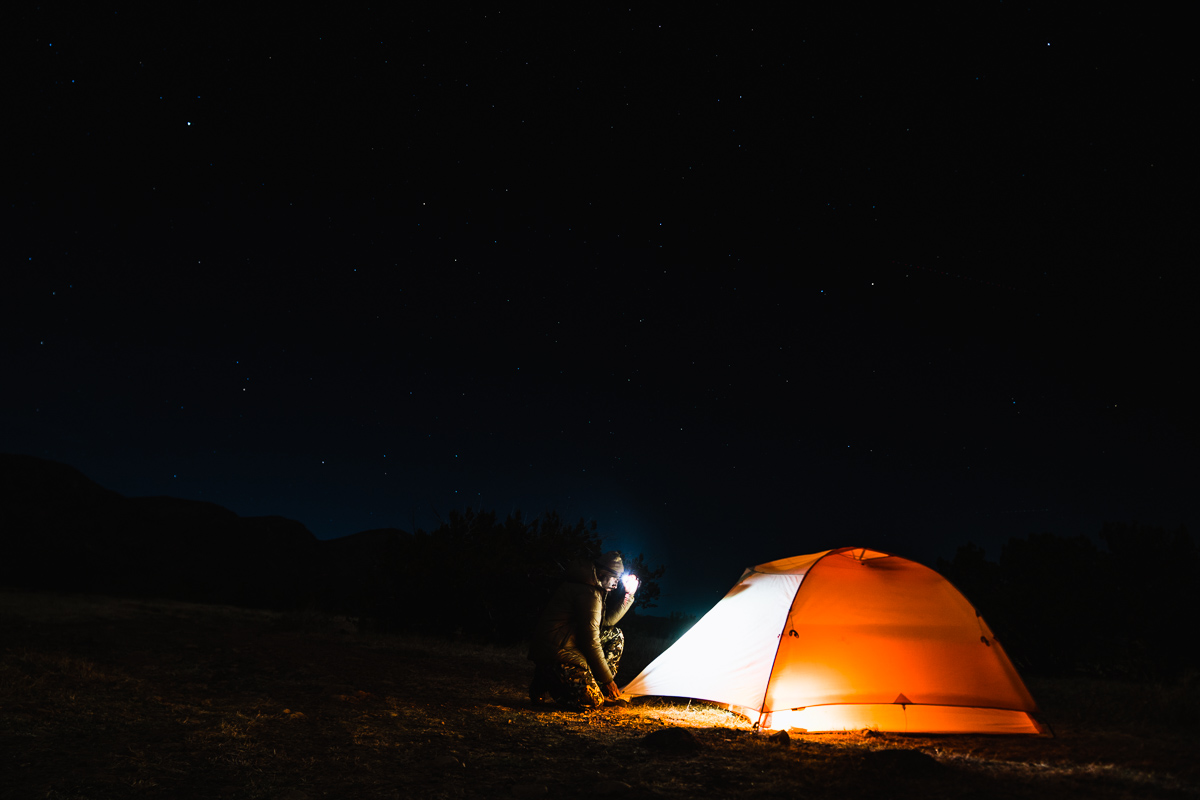
Backpack hunting is hard enough as it is. From negotiating demanding country to just going through the motions of backcountry living, it can chip away at a person. And that doesn’t even touch on the hunting part and everything that comes along with that. To have a shelter that works against you, rather than with you, is not something that one has to “just deal with.” With how many options there are, there is no reason for that. So, while it may be vast, the swim through this sea of backcountry shelters we’ve talked about doesn’t have to be an arduous one. Use this as a stepping stone to lead you on your way to the perfect shelter.


